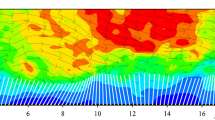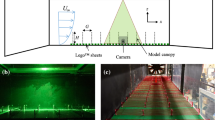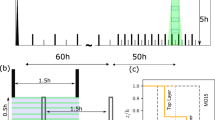Abstract
Natural plants have different morphologies, which may impact the velocity and turbulence structures inside the canopy interior. Laboratory experiments investigated streamwise velocity and turbulent kinetic energy (TKE) profiles inside a Phragmites australis canopy with natural morphology. Inside the canopies, velocity and TKE adjusted both in the streamwise and vertical directions. An exponential-based velocity model for a canopy with vertically uniform frontal areas (e.g., a cylinder array) was modified to predict the longitudinal profile of depth-averaged velocity inside a canopy with vertically varying frontal areas (e.g., a P. australis canopy). Considering the influence of plant morphology, the vertical profiles of velocity and TKE at each streamwise position were predicted using the predicted depth-averaged velocity and the frontal area of the plants. The predicted velocity and TKE had good agreement with the measurements, suggesting that the present study provides a valid method to predict the velocity and TKE profiles inside canopies with natural morphology. Plants with a greater vertical variation in the frontal area have a more significant influence on predictions, and this influence should be included to avoid overestimating velocity and TKE.
Key points
-
[1]
Within a P. australis canopy, a velocity model for cylinder arrays was modified to predict the longitudinal profile of depth-averaged velocity.
-
[2]
Based on predicted depth-averaged velocities, the vertical profiles of velocity and TKE were predicted at different positions within canopies with real morphology.
-
[3]
With the same equivalent diameter and flow depth, a greater variation in plant morphology produced a more significant overestimated velocity and TKE.










Similar content being viewed by others
References
Bal KD, Struyf E, Vereecken H, Viaene P, De Doncker L, de Deckere E, Mostaert F, Meire P (2011) How do macrophyte distribution patterns affect hydraulic resistances? Ecol Eng 37(3):529–533. https://doi.org/10.1016/j.ecoleng.2010.12.018
Belcher SE, Jerram N, Hunt JCR (2003) Adjustment of a turbulent boundary layer to a canopy of roughness elements. J Fluid Mech 488:369–398. https://doi.org/10.1017/S0022112003005019
Bouma TJ, Duren LAV, Temmerman S, Claverie T, Blanco-Garcia A, Ysebaert T, Herman PMJ (2007) Spatial flow and sedimentation patterns within patches of epibenthic structures: combining field, flume and modeling experiments. Cont Shelf Res 27(8):1020–1045. https://doi.org/10.1016/j.csr.2005.12.019
Caroppi G, Västilä K, Järvelä J, Rowiński PM, Giugni M (2019) Turbulence at water-vegetation interface in open channel flow: experiments with natural-like plants. Adv Water Resour 127:180–191
Caroppi G, Gualtieri P, Fontana N, Giugni M (2020) Effects of vegetation density on shear layer in partly vegetated channels. J Hydro Environ Res. https://doi.org/10.1016/j.jher.2020.01.008
Caroppi G, Västilä K, Gualtieri P, Järvelä J, Giugni M, Rowiński PM (2021) Comparison of flexible and rigid vegetation induced shear layers in partly vegetated channels. Water Resour Res 57(3):e2020WR028243
Chen Z, Jiang C, Nepf H (2013) Flow adjustment at the leading edge of a submerged aquatic canopy. Water Resour Res 49(9):5537–5551. https://doi.org/10.1002/wrcr.20403
Devi T, Sharma A, Kumar B (2019) Flow characteristics in a partly vegetated channel with emergent vegetation and seepage. Ecohydrol Hydrobiol 19(1):93–108. https://doi.org/10.1016/j.ecohyd.2018.07.006
Etminan M, Ghisalberti R, Lowe J (2018) Predicting bed shear stresses in vegetated channels. Water Resour Res 54(11):9187–9206. https://doi.org/10.1029/2018WR022811
Elliott SH, Tullos DD, Walter C (2019) Physical modeling of the feedbacks between a patch of flexible reed canarygrass (Phalaris arundinacea), wake hydraulics, and downstream deposition. Environ Fluid Mech 19(1):255–277
Fu H, Shan Y, Liu C (2023). A model for predicting the grain size distribution of an armor layer under clear water scouring Journal of Hydrology 623:129842. https://doi.org/10.1016/j.jhydrol.2023.129842
Gacia E, Soto DX, Roig R, Catalan J (2021) Phragmites australis as a dual indicator (air and sediment) of trace metal pollution in wetlands–the key case of Flix reservoir (Ebro River). Sci Total Environ 765:142789
Goring G, Nikora V (2002) Despiking acoustic doppler Velocimeter data. J Hydraulic Eng 128(1):117–126. https://doi.org/10.1061/(ASCE)0733-9429(2002)128:1(117)
Gu J, Shan Y, Liu C, Liu X (2019) Feedbacks of flow and bed morphology from a submerged dense vegetation patch without upstream sediment supply. Environ Fluid Mech 19(2):475–493. https://doi.org/10.1007/s10652-018-9633-5
Gui Z, Shan Y, Liu C (2023) Flow velocity evolution through a floating rigid cylinder array under unidirectional flow. J Hydrol 617:128915. https://doi.org/10.1016/j.jhydrol.2022.128915
Huai WX, Li S, Katul GG, Liu MY, Yang ZH (2021) Flow dynamics and sediment transport in vegetated rivers: a review. J Hydrodyn 33(3):400–420. https://doi.org/10.1007/s42241-021-0043-7
Huai WX, Zhang J, Wang WJ, Katul GG (2019) Turbulence structure in open channel flow with partially covered artificial emergent vegetation. J Hydrol 573:180–193. https://doi.org/10.1016/j.jhydrol.2019.03.071
Kim HS, Kimura I, Shimizu Y (2015) Bed morphological changes around a finite patch of vegetation. Earth Surf Proc Land 40(3):375–388. https://doi.org/10.1002/esp.3639
King AT, Tinoco RO, Cowen EA (2012) A k–ε turbulence model based on the scales of vertical shear and stem wakes valid for emergent and submerged vegetated flows. J Fluid Mech 701:1–39
Li Y, Du W, Yu Z, Tang C, Wang Y, Anim DO et al (2015) Impact of flexible emergent vegetation on the flow turbulence and kinetic energy characteristics in a flume experiment. J Hydro Environ Res 9(3):354–367
Li F, Shan Y, Huang S, Liu C, Liu X (2021) Flow depth, velocity, and sediment motions in a straight widened channel with vegetated floodplains. Environ Fluid Mech 21(2):483–501
Licci S, Nepf H, Delolme C et al (2019) The role of patch size in ecosystem engineering capacity: a case study of aquatic vegetation. Aquat Sci. https://doi.org/10.1007/s00027-019-0635-2
Liu C, Nepf H (2016) Sediment deposition within and around a finite patch of model vegetation over a range of channel velocity. Water Resour Res 52(1):600–612. https://doi.org/10.1002/2015WR018249
Liu C, Shan Y, Liu X, Yang K, Liao H (2016) The effect of floodplain grass on the flow characteristics of meandering compound channels. J Hydrol 542:1–17. https://doi.org/10.1016/j.jhydrol.2016.07.037
Liu C, Shan Y (2019) Analytical model for predicting the longitudinal profiles of velocities in a channel with a model vegetation patch. J Hydrol 576:561–574. https://doi.org/10.1016/j.jhydrol.2019.06.076
Liu C, Shan YQ, Sun W, Yan CH, Yang KJ (2020) An open channel with an emergent vegetation patch: Predicting the longitudinal profiles of velocities based on exponential decay. J Hydrol 582:124429. https://doi.org/10.1016/j.jhydrol.2019.124429
Liu C, Shan YQ, Nepf H (2021) Impact of stem size on turbulence and sediment resuspension under unidirectional flow. Water Resour Res 57:e2020WR028620. https://doi.org/10.1029/2020WR028620
Liu C, Yan C, Shan Y, Guo Y (2022) An exponential-based model for predicting velocity fields in partially vegetated channels. J Hydraul Res 60(6):864–879. https://doi.org/10.1080/00221686.2022.2067084
Liu C, Yan C, Sun S, Lei J, Nepf H, Shan Y (2022) Velocity, turbulence, and sediment deposition in a channel partially filled with a Phragmites australis canopy. Water Resour Res 58:e2022WR032381. https://doi.org/10.1029/2022WR032381
Liu C, Shan Y (2022) Impact of an emergent model vegetation patch on flow adjustment and velocity. Proc Inst Civ Eng Water Manag 175(2):55–66. https://doi.org/10.1680/jwama.20.00108
Lightbody AF, Nepf HM (2006) Prediction of velocity profiles and longitudinal dispersion in salt marsh vegetation. Limnol Oceanogr 51(1):218–228. https://doi.org/10.4319/lo.2006.51.1.0218
Losada IJ, Maza M, Lara JL (2016) A new formulation for vegetation-induced damping under combined waves and currents. Coast Eng 107:1–13
Manners RB, Wilcox AC, Li K, Lightbody AF, Stella JC, Sklar LS (2015) When do plants modify fluvial processes? Plant-hydraulic interactions under variable flow and sediment supply rates. J Geophys Res Earth Surface 120(2):325–345. https://doi.org/10.1002/2014JF003265
Nepf H (2012) Flow and transport in regions with aquatic vegetation. Annu Rev Fluid Mech 44(1):123–142. https://doi.org/10.1146/annurev-fluid-120710-101048
Rominger JT, Nepf H (2011) Flow adjustment and interior flow associated with a rectangular porous obstruction. J Fluid Mech 680:636–659. https://doi.org/10.1017/jfm.2011.199
Sand-Jensen KAJ, Pedersen ML (2008) Streamlining of plant patches in streams. Freshwater Biol 53(4):714–726. https://doi.org/10.1111/j.1365-2427.2007.01928.x
Schoelynck J, Meire D, Bal K, Buis K, Troch P, Bouma T, Meire P, Temmerman S (2013) Submerged macrophytes avoiding a negative feedback in reaction to hydrodynamic stress. Limnologica 43(5):371–380. https://doi.org/10.1016/j.limno.2013.05.003
Shan Y, Liu X, Yang K, Liu C (2017) Analytical model for stage-discharge estimation in meandering compound channels with submerged flexible vegetation. Adv Water Resour 108:170–183. https://doi.org/10.1016/j.advwatres.2017.07.021
Shan Y, Liu C, Nepf H (2019) Comparison of drag and velocity in model mangrove forests with random and in-line tree distributions. J Hydrol 568:735–746
Shan Y, Zhao T, Liu C, Nepf H (2020) Turbulence and bed-load transport in channels with randomly distributed emergent patches of model vegetation. Geophys Res Lett 47(143–153):e2020GL087055. https://doi.org/10.1029/2020GL087055
Sonnenwald F, Guymer I, Stovin V (2019) A CFD-based mixing model for vegetated flows. Water Resour Res 55(3):2322–2347
Tanino Y, Nepf HM (2008) Lateral dispersion in random cylinder arrays at high Reynolds number. J Fluid Mech 600:339–371. https://doi.org/10.1017/S0022112008000505
Vandenbruwaene W, Temmerman S, Bouma TJ, Klaassen PC, de Vries MB, Callaghan DP, Meire P (2011) Flow interaction with dynamic vegetation patches: implications for biogeomorphic evolution of a tidal landscape. J Geophys Res Earth Surf 116(F1):155–170. https://doi.org/10.1029/2010jf001788
Vandenbruwaene C, Schwarz TJ, Bouma P, Meire S, Temmerman (2015) Landscape-scale flow patterns over a vegetated tidal marsh and an unvegetated tidal flat: Implications for the landform properties of the intertidal floodplain. Geomorphology 231:40–52. https://doi.org/10.1016/j.geomorph.2014.11.020
Verschoren V, Meire D, Schoelynck J, Buis K, Bal KD, Troch P, Temmerman S (2016) Resistance and reconfiguration of natural flexible submerged vegetation in hydrodynamic river modeling. Environ Fluid Mech 16(1):245–265
White FM (1991) Viscous fluid flow [M] (2nd ed). McGraw-Hill
White BL, Nepf H (2008) A vortex-based model of velocity and shear stress in a partially vegetated shallow channel. Water Resour Res 44:W01412. https://doi.org/10.1029/2006WR005651
Widdows J, Pope ND, Brinsley MD (2008) Effect of Spartina anglica stems on near-bed hydrodynamics, sediment erodability and morphological changes on an intertidal mudflat. Mar Ecol Prog Ser 362:45–57. https://doi.org/10.3354/meps07448
Xu Y, Nepf H (2020) Measured and predicted turbulent kinetic energy in flow through emergent vegetation with real plant morphology. Water Resour Res 56(12):e2020WR027892. https://doi.org/10.1029/2020WR027892
Yan C, Shan Y, Liu C, Liu X (2022) Analytical model for predicting the lateral profiles of velocities through a partially vegetated channel. J Hydrol 612:128137. https://doi.org/10.1016/j.jhydrol.2022.128137
Yu Z, Shan Y, Liu C, Liu X (2021) Wake flow and vortex structures behind emergent vegetation patches elongated in the longitudinal direction. J Hydrodyn 33(6):1148–1161. https://doi.org/10.1007/s42241-022-0112-6
Yang J, Nepf H (2018) A turbulence-based bed-load transport model for bare and vegetated channels. Geophys Res Lett 45(19):10428–10436. https://doi.org/10.1029/2018GL079319
Zhang J, Wang W, Shi H, Wang W, Li Z, Xia Z (2021) Two-zone analysis of velocity profiles in a compound channel with partial artificial vegetation cover. J Hydrol 596:126147. https://doi.org/10.1016/j.jhydrol.2021.126147
Zong L, Nepf H (2010) Flow and deposition in and around a finite patch of vegetation. Geomorphology 116:363–372. https://doi.org/10.1016/j.geomorph.2009.11.020
Zong L, Nepf H (2011) Spatial distribution of deposition within a patch of vegetation. Water Resour Res 47:W03516. https://doi.org/10.1029/2010WR009516
Acknowledgements
We sincerely appreciate the editor’s and two reviewers’ comments and very constructive suggestions, which improved the paper quality.
Funding
This study received financial support from the National Key Research and Development Program of China (No. 2022YFE0136700), the National Natural Science Foundation of China (Nos. 52022063 and 52179074), the Sichuan Science and Technology Program (Nos. 2021YFH0028 and 2022NSFSC0969), and the Open Fund Program (No. 2021SKSH05) at the Key Laboratory of Poyang Lake Water Resources and Environment of Jiangxi Province, Jiangxi Academy of Water Science and Engineering.
Author information
Authors and Affiliations
Contributions
YS and CL proposed the concept, theory and the predictive method. CY, YS and CL designed the experiment. CY performed the experiment and data analysis. YS, CY and JL prepared the original manuscript. CL reviewed and edited the manuscript. The project was supervised by YS and CL.
Corresponding author
Ethics declarations
Conflict of interest
The authors declare that there is no conflict of interest.
Additional information
Publisher's Note
Springer Nature remains neutral with regard to jurisdictional claims in published maps and institutional affiliations.
Rights and permissions
Springer Nature or its licensor (e.g. a society or other partner) holds exclusive rights to this article under a publishing agreement with the author(s) or other rightsholder(s); author self-archiving of the accepted manuscript version of this article is solely governed by the terms of such publishing agreement and applicable law.
About this article
Cite this article
Shan, Y., Yan, C., Liu, J. et al. Predicting velocity and turbulent kinetic energy inside an emergent Phragmites australis canopy with real morphology. Environ Fluid Mech 23, 943–963 (2023). https://doi.org/10.1007/s10652-023-09942-0
Received:
Accepted:
Published:
Issue Date:
DOI: https://doi.org/10.1007/s10652-023-09942-0




